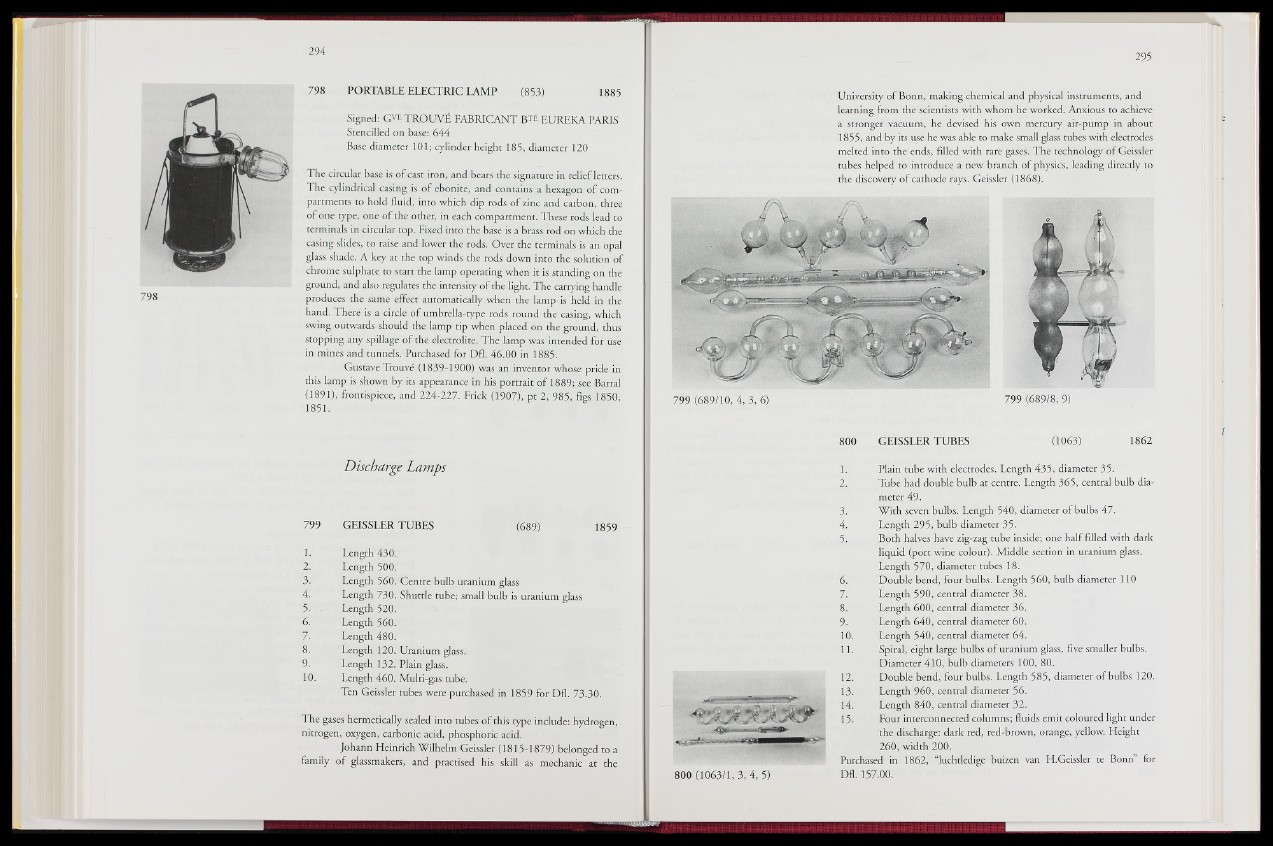
798 PORTABLE ELECTRIC LAMP (853) 1885
Signed: G™ TROUVÉ FABRICANT BTÉ EUREKA PARIS
Stencilled on base: 644
Base diameter 101; cylinder height 185, diameter 120
The circular base is of cast iron, and bears the signature in relief letters.
The cylindrical casing is of ebonite, and contains a hexagon of compartments
to hold fluid, into which dip rods of zinc and carbon, three
of one type, one of the other, in each compartment. These rods lead to
terminals in circular top. Fixed into the base is a brass rod on which the
casing slides, to raise and lower the rods. Over the terminals is an opal
glass shade. A key at the top winds the rods down into the solution of
chrome sulphate to start the lamp operating when it is standing on the
ground, and also regulates the intensity of the light. The carrying handle
produces the same effect automatically when the lamp is held in the
hand. There is a circle of umbrella-type rods round the casing, which
swing outwards should the lamp tip when placed on the ground, thus
stopping any spillage of the electrolite. The lamp was intended for use
in mines and tunnels. Purchased for Dfl. 46.00 in 1885.
Gustave Trouvé (1839-1900) was an inventor whose pride in
this lamp is shown by its appearance in his portrait of 1889; see Barrai
(1891), frontispiece, and 224-227. Frick (’§907), pt 2, 985, figs 1850,
1851.
Discharge Lamps
799 GEISSLER TUBES (689) 1859
1. Length 430..
2. Length 500.
3. Length 560. Centre bulb uranium glass
4. Length 730. Shuttle tube; small bulb is uranium glass
5. . Length 520.
6. Length 560.
Bp Length 480.
8. Length 120. Uranium glass.
9. Length 132. Plain glass.
10. Length 460. Multi-gas tube.
Ten Geissler tubes were purchased in 1859 for Dfl. 73.30.
The gases hermetically sealed into tubes of this type include: hydrogen,
nitrogen, oxygen, carbonic acid, phosphoric acid.
Johann Heinrich Wilhelm Geissler (1815-1879) belonged to a
family of glassmakers, and practised his skill as mechanic at the
University of Bonn, making chemical and physical instruments, and
learning from the scientists with whom he worked. Anxious to achieve
a stronger vacuum, he devised his own mercury air-pump in about
1855, and by its use he was able to make small glass tubes with electrodes
melted into the ends, filled with rare gases. The technology of Geissler
tubes helped to introduce a new branch of physics, leading directly to
the discovery of cathode rays. Geissler (1868).
799 (689/8, 9)
800 GEISSLER TUBES (1063) 1862
M r Plain tube with electrodes. Length 435, diameter 35.
2. Tube had double bulb at centre. Length 365, central bulb diameter
49.
3. With seven bulbs. Length 540, diameter of bulbs 47.
4. Length 295, bulb diameter 35.
5. Both halves have zig-zag tube inside; one half filled with dark
liquid (port wine colour). Middle section in uranium glass.
Length 570, diameter tubes 18.
6. Double bend, four bulbs'. Length 560, bulb diameter 110
73 , Length 590, central diameter 38.
8. Length 600, central diameter 36.
9. Length 640, central diameter 60.
10. Length 540, central diameter 64.
11. Spiral, eight large bulbs of uranium glass, five smaller bulbs.
Diameter 410, bulb diameters 100, 80.
12. Double bend, four bulbs. Length 585, diameter of bulbs 120.
13. Length 960, central diameter 56.
14. Length 840, central diameter 32.
15. Four interconnected columns; fluids emit coloured light under
the discharge: dark red, red-brown, orange, yellow. Height
260, width 200.
Purchased in 1862, 8luchrledigc buizen van H.Geissler te Bonn” for
Dfl. 157-00.